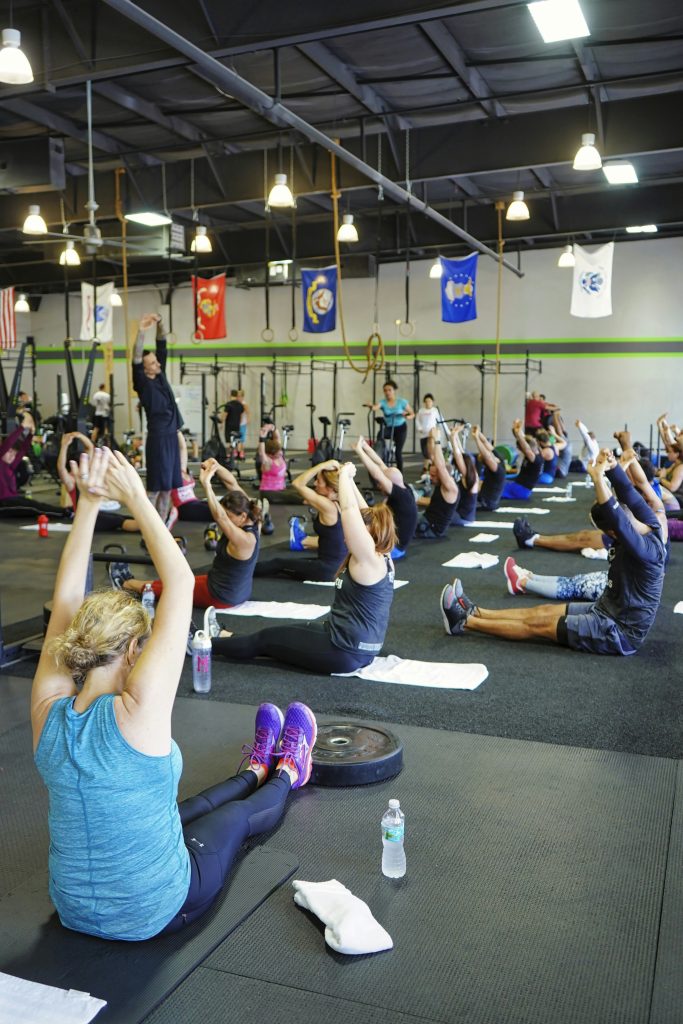If you’re looking to build six pack abs and strengthen your core muscles, incorporating ab workouts into your full-body circuit training routine is key. Many people have questions about how to effectively target their abs while still getting a well-rounded workout. In this article, we will explore different strategies and exercises that will help you seamlessly integrate ab workouts into your circuit training routine, allowing you to maximize your results and achieve a toned and strong core. So, whether you’re a fitness enthusiast or just starting your fitness journey, read on to discover the best ways to incorporate ab workouts into a full-body circuit training routine.
Benefits of Incorporating Ab Workouts into Full-Body Circuit Training
Strengthening Core Muscles
Ab workouts are an essential component of full-body circuit training because they help strengthen the core muscles. Your core muscles, which include the rectus abdominis, obliques, and transverse abdominis, play a crucial role in stabilizing your body and supporting your spine during movement. By incorporating ab exercises into your circuit training routine, you can effectively target and strengthen these muscles.
A strong core not only improves your overall stability and posture but also enhances your performance in other exercises. Whether you’re running, squatting, or doing push-ups, a strong core allows you to generate more power and maintain proper form. It acts as a solid foundation for your body, ensuring that you can perform movements more efficiently and with reduced risk of injury.
Improving Stability and Balance
In addition to strengthening your core, incorporating ab workouts into your full-body circuit training routine can also improve your stability and balance. Ab exercises often involve maintaining specific positions or performing movements that challenge your body’s balance. By consistently training your core muscles in this way, you can enhance your proprioception, which is your body’s ability to sense its position and movement in space.
With improved stability and balance, you’ll not only be less prone to falls and injuries but also be able to perform other exercises with better control. Whether you’re performing lunges, overhead presses, or even yoga poses, a strong core and improved balance will allow you to maintain proper alignment and engage the targeted muscles more effectively.
Enhancing Functional Fitness
One of the key benefits of incorporating ab workouts into full-body circuit training is the enhancement of functional fitness. Functional fitness refers to the ability to perform everyday activities with ease and efficiency. By focusing on compound movements and training multiple muscle groups at once, circuit training is already a great way to improve functional fitness. Adding ab exercises further increases the effectiveness of this training modality.
A strong core is essential for performing everyday activities, such as lifting groceries, carrying your child, or even performing household chores. By incorporating ab workouts into your circuit training routine, you’re specifically targeting the core muscles that are crucial for these types of movements. This functional approach to training ensures that your fitness gains directly translate into improved performance in daily life.
Increasing Calorie Burn
Another significant benefit of incorporating ab workouts into full-body circuit training is the increase in calorie burn. Ab exercises not only target the core muscles but also activate other muscle groups, such as the glutes, hip flexors, and shoulders. When you engage multiple muscle groups simultaneously, you increase the overall intensity of your workout, leading to greater caloric expenditure.
Including ab exercises in your circuit training routine can help elevate your heart rate and increase the metabolic demand of the workout. This means that you’ll continue burning calories even after you’ve finished exercising. This increase in calorie burn can be especially beneficial if your goal is weight loss or improved body composition.
Choosing the Right Ab Exercises for Circuit Training
Compound Ab Exercises
When selecting ab exercises for your circuit training routine, it’s important to choose compound movements that engage multiple muscle groups. Compound ab exercises involve dynamic movements that incorporate not only the core muscles but also other muscle groups, such as the legs and upper body.
Exercises like mountain climbers, Russian twists, and bicycle crunches are great examples of compound ab exercises. These movements require coordination, balance, and stability, which further enhance the effectiveness of your circuit training routine. Remember to choose exercises that challenge your current fitness level while allowing for proper form and technique.
Isolation Ab Exercises
While compound ab exercises are effective, it’s also beneficial to include isolation exercises in your circuit training routine to specifically target and enhance the strength of your core muscles. Isolation ab exercises focus solely on the core muscles, allowing you to work them with more precision and intensity.
Exercises such as planks, side planks, and reverse crunches are excellent choices for isolation ab exercises. These exercises isolate and strengthen the deep stabilizing muscles of the core, leading to improved core strength and stability. Including isolation ab exercises in your circuit training routine ensures that you’re targeting all aspects of your core muscles effectively.
Variety and Progression
Lastly, it’s important to incorporate variety and progression into your selection of ab exercises for circuit training. Switching up your exercises regularly not only prevents boredom but also ensures that your muscles are challenged in different ways.
Include a mix of different ab exercises that target various areas of the core, such as the upper abs, lower abs, and obliques. This variety will ensure that all areas of your core are adequately strengthened. Additionally, progress your ab exercises by increasing the difficulty, such as adding weights, increasing repetitions, or reducing rest periods, to continuously challenge and improve your core strength.

Designing a Full-Body Circuit Training Routine with Ab Workouts
Determining Exercise Order
When designing a full-body circuit training routine that includes ab workouts, it’s essential to carefully consider the exercise order. Typically, it’s best to start with compound movements that engage multiple muscle groups and require maximum effort. These exercises often require more energy and focus, so performing them at the beginning of your workout ensures that you’re fresh and able to execute proper form.
Following the compound movements, you can progress to isolation ab exercises to specifically target and further fatigue the core muscles. This order prioritizes the core muscles and allows you to perform the ab exercises with proper technique and control.
Balancing Upper and Lower Body Exercises
Incorporating a balance of upper and lower body exercises is important in a full-body circuit training routine. While ab workouts focus on the core, it’s crucial to involve the other major muscle groups in your body to create a well-rounded workout.
Alternating between upper and lower body exercises helps to maintain balance and prevent muscle imbalances. For example, if you perform a challenging upper body exercise, such as push-ups or dumbbell rows, follow it with a lower body exercise like lunges or squats. This alternation allows for proper muscle recovery and ensures that you’re giving equal attention to all areas of your body.
Including Cardiovascular Conditioning
To create a truly full-body circuit training routine, it’s important to include cardiovascular conditioning exercises. These exercises increase your heart rate, promote cardiovascular health, and contribute to overall calorie burn.
Include exercises like jumping jacks, high knees, or mountain climbers to elevate your heart rate and keep it elevated throughout your workout. By incorporating cardiovascular conditioning exercises in between your strength exercises, you can create a circuit that not only strengthens your core but also improves your cardiovascular fitness.
Sample Full-Body Circuit Training Routine with Ab Workouts
Dynamic Warm-Up
Before beginning your full-body circuit training routine, it’s essential to warm up your body properly. A dynamic warm-up helps increase blood flow to your muscles, improves muscle elasticity, and prepares your body for the upcoming workout.
Include exercises like arm circles, leg swings, torso twists, and walking lunges in your warm-up routine. These movements engage the entire body, gradually increase your heart rate, and activate the muscles you’ll be using during your workout.
Upper Body Exercise Circuit
Start your circuit training routine with an upper body exercise circuit that targets the muscles of your arms, shoulders, and chest. Include exercises such as push-ups, dumbbell curls, overhead presses, and tricep dips. Perform each exercise for a specific number of repetitions or a set time period before transitioning to the next exercise with minimal rest.
Lower Body Exercise Circuit
After completing the upper body exercise circuit, move on to a lower body exercise circuit. This circuit can include exercises like squats, lunges, step-ups, and hamstring curls. Again, perform each exercise for a set number of repetitions or time period and transition between exercises with minimal rest.
Ab Workout Circuit
Following the lower body exercise circuit, it’s time to focus on your core with an ab workout circuit. Include a mix of compound and isolation ab exercises, such as planks, Russian twists, reverse crunches, and bicycle crunches. Perform each exercise for the recommended number of repetitions or time period, and aim for at least three rounds of the circuit.
Cardiovascular Conditioning
After completing the ab workout circuit, it’s time to elevate your heart rate with cardiovascular conditioning exercises. Perform exercises like jumping jacks, mountain climbers, or high knees for a set time period or repetitions. This cardio component of the circuit training routine helps maximize calorie burn and contributes to overall cardiovascular fitness.
Cool Down and Stretching
Finally, end your full-body circuit training routine with a cool down and stretching session. Allow your heart rate and breathing to return to normal by performing light aerobic activity, such as walking or jogging in place. Once your heart rate has slowed down, incorporate stretches for all major muscle groups, focusing on the areas you targeted during your workout.

Tips for Effective Ab Workouts in Circuit Training
Proper Form and Technique
Regardless of the specific ab exercises you choose, proper form and technique are crucial for effectiveness and injury prevention. Take the time to understand and execute each exercise correctly. Engage your core muscles, maintain proper alignment, and avoid using momentum or relying on other muscle groups to perform the movements.
If you’re unsure of the correct form, consider working with a qualified personal trainer who can ensure that you’re performing the exercises safely and effectively. Remember, quality and technique should always take precedence over quantity.
Progressive Overload
To continually improve your core strength and see progress, it’s important to incorporate progressive overload into your ab workouts. Progressive overload involves gradually increasing the intensity, duration, or difficulty of your exercises over time. This challenges your muscles to adapt and grow stronger.
You can incorporate progressive overload by increasing the number of repetitions, adding resistance (such as weights or resistance bands), holding positions for longer periods, or introducing more challenging variations of the exercises. Aim to progressively challenge your core muscles every few weeks to keep seeing improvements.
Rest and Recovery
While it’s important to challenge your core muscles with ab workouts, it’s equally important to prioritize rest and recovery. Your muscles need time to repair and rebuild after intense exercise. Overtraining can lead to fatigue, decreased performance, and increased risk of injury.
Allow for at least one day of rest between intense ab workouts to give your muscles time to recover. Alternatively, you can incorporate active recovery techniques, such as light stretching or low-intensity aerobic exercise, on your rest days.
Monitoring and Adjusting Intensity
Listen to your body and pay attention to any signs of pain or discomfort. It’s normal to feel some muscle soreness after a challenging workout, but sharp or intense pain may indicate an injury. If you experience pain, reduce the intensity or modify the exercise accordingly.
Additionally, be mindful of your breathing during ab workouts. Avoid holding your breath, as it can increase tension and interfere with proper muscle activation. Instead, breathe rhythmically and exhale during the exertion phase of each exercise.
Additional Considerations
Mixing and Matching Exercises
Feel free to mix and match different ab exercises to create a variety of circuits and combat boredom. There’s no one-size-fits-all approach to ab workouts, and experimenting with different exercises can help you discover which ones you enjoy the most and find the most effective.
Consider alternating between circuits that focus on compound movements and circuits that emphasize isolation exercises. This variety will ensure that you’re constantly challenging your core muscles in different ways and targeting various muscle groups.
Duration and Frequency
The duration and frequency of your ab workouts in circuit training will depend on your fitness level, goals, and overall training plan. Aim for at least two to three ab workouts per week, leaving at least one day of rest between sessions. Each session can range from 15 to 30 minutes, depending on the intensity and the number of exercises included.
As you progress and become more comfortable, you can increase the duration or frequency of your ab workouts, but always listen to your body and avoid overtraining.
Nutrition and Hydration
Incorporating ab workouts into your full-body circuit training routine is only one aspect of developing a strong core. A well-balanced diet and proper hydration are also crucial for achieving optimal results. Ensure you’re consuming enough protein to support muscle repair and growth, as well as a variety of fruits, vegetables, whole grains, and healthy fats to fuel your workouts.
Hydration is equally important, as water plays a vital role in maintaining the health and function of your muscles. Aim to drink plenty of water throughout the day, especially before, during, and after your workouts.
Listening to Your Body
Finally, always listen to your body during ab workouts and circuit training. If something doesn’t feel right or causes pain, don’t push through it. Modify or switch to a different exercise that feels more comfortable.
Remember that everyone’s fitness level and abilities are unique. It’s okay to start with modified or simplified versions of exercises and gradually progress as you become stronger and more confident. Always prioritize safety and work within your own limits.

Common Mistakes to Avoid
Neglecting Form for Quantity
One common mistake when incorporating ab workouts into circuit training is prioritizing quantity over quality. It’s important to prioritize proper form and technique over the number of repetitions you can perform.
Avoid rushing through exercises and sacrificing form to complete more repetitions. Instead, focus on performing each exercise with strict form, engaging the correct muscles, and maintaining control throughout the movement. Performing fewer repetitions with proper form is much more effective than performing many repetitions with poor form.
Performing Ineffective Ab Exercises
Not all ab exercises are created equal, and it’s important to choose exercises that effectively target the core. Avoid exercises that mainly engage other muscle groups or fail to activate the core effectively.
Instead, choose exercises that specifically target the core muscles and challenge them in a controlled and progressive manner. Refer to reputable sources or seek the guidance of a qualified fitness professional to ensure you’re performing exercises that effectively work your core.
Neglecting Other Muscle Groups
While ab workouts are important for core strength, it’s crucial to remember that a balanced full-body workout targets all major muscle groups. Neglecting other muscle groups can lead to muscle imbalances, which can increase the risk of injury and negatively impact overall strength and fitness.
Ensure your circuit training routine includes exercises that target the upper and lower body muscles, such as the chest, back, arms, legs, and glutes. A balanced workout routine will support overall strength and stability throughout the body.
Overtraining the Abs
Although it’s important to challenge your core muscles, overtraining them can be counterproductive. Just like any other muscle group, your abs need proper rest and recovery to repair and grow stronger.
Avoid training your core intensely every day. Instead, allow for at least one day of rest between intense ab workouts. This rest period will give your muscles time to recover and adapt to the stimulus, leading to better overall progress and injury prevention.
Incorporating Variety in Ab Workouts
Core Stability Exercises
Core stability exercises are great additions to your ab workouts as they focus on strengthening the deep stabilizing muscles of the core. These exercises often involve maintaining specific positions that challenge your balance and stability.
Include exercises like planks, side planks, and bird dogs in your ab workouts to improve core stability. These exercises not only target the rectus abdominis and obliques but also engage the important stabilizer muscles surrounding your spine.
Flexion and Rotation Exercises
Flexion and rotation exercises are effective for targeting different areas of your core and challenging the muscles from different angles. These exercises involve movements that flex or rotate the spine while engaging the abdominal muscles.
Include exercises such as Russian twists, bicycle crunches, and seated twists in your ab workouts to target the muscles responsible for flexion and rotation. These exercises can help develop strength in the obliques and the deeper muscles of the core.
Plank Variations
Planks are versatile exercises that can be modified to increase the challenge and target specific muscle groups within the core. Instead of just holding a traditional plank, consider incorporating variations that engage different muscle groups.
Include exercises such as side planks, plank jacks, and plank with leg lifts to add variety and intensity to your ab workouts. These variations engage the obliques, transverse abdominis, and other stabilizer muscles to further strengthen your core.
Ab Wheel Rollouts
Ab wheel rollouts are a challenging yet effective exercise that targets multiple areas of the core, including the rectus abdominis, obliques, and transverse abdominis. This exercise not only requires strength but also coordination and stability.
Start by kneeling on the floor and holding an ab wheel or a stability ball in front of you. Slowly roll the wheel forward while keeping your core engaged and your spine neutral. Roll out as far as you can while maintaining proper form, then roll back to the starting position. Incorporate ab wheel rollouts into your ab workouts to challenge your core in a unique way.

Tracking Progress and Making Adjustments
Setting Goals and Measuring Success
To stay motivated and track your progress, it’s important to set measurable goals related to your ab workouts and overall fitness. Whether your goal is to increase core strength, improve endurance, or enhance your aesthetic appearance, setting specific goals allows you to focus your efforts and measure your success.
Consider setting goals such as increasing the amount of time you can hold a plank, improving your performance in specific ab exercises, or achieving a certain number of repetitions. Track your progress over time and celebrate your achievements along the way.
Tracking Exercise Performance and Repetitions
To ensure consistent progress, it’s helpful to track your exercise performance and the number of repetitions you can perform for each ab exercise. Keeping a workout journal or using a fitness tracking app can help you easily monitor and review your progress.
By tracking your exercise performance, you can identify areas of improvement, ensure progressive overload, and adjust your training plan accordingly. This data-driven approach allows you to make informed decisions about the intensity, duration, and variation of your ab workouts.
Adjusting Difficulty and Intensity
As you become stronger and more experienced in your ab workouts, it’s important to continuously adjust the difficulty and intensity of your exercises. Your core muscles adapt over time, so it’s necessary to challenge them in new ways to continue seeing progress.
Increase the difficulty of your ab exercises by adding weights, using resistance bands, or introducing advanced variations. You can also adjust the intensity by reducing rest periods, increasing the number of repetitions, or combining exercises into supersets or circuits.
Conclusion
Incorporating ab workouts into your full-body circuit training routine offers numerous benefits, including strengthening core muscles, improving stability and balance, enhancing functional fitness, and increasing calorie burn. By carefully selecting the right ab exercises, designing a well-rounded circuit training routine, and following tips for effective ab workouts, you can achieve a stronger core and overall improved fitness. Remember to track your progress, listen to your body, and find a routine that works for you. With consistency and progression, you can develop strong abs and enjoy the many benefits of a well-trained core.






